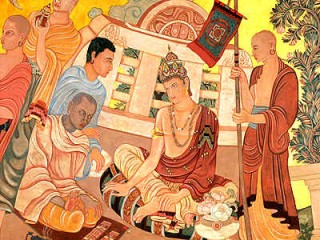
Chandragupta Maurya biography
Date of birth : -
Date of death : -
Birthplace : Magadha, Bihar, Maurya Empire
Nationality : Mauryan
Category : Historian personalities
Last modified : 2011-02-01
Credited as : Emperor of India, founder of the Maurya Dynasty and Empire, Sandracottus
Chandragupta Maurya (died ca. 298 B.C.) was the founder of the Maurya dynasty and the first historical emperor of India.
According to the Puranic tradition, Chandragupta, also known as Sandracottus, was the illegitimate son of the last Nanda king of Magadha by the maid servant Mura, hence the name Maurya. Jain and Buddhist sources declare him to be a scion of the Moriya clan of Pippalivana.
In his youth Chandragupta came under the influence of Chanakya, also known as Kautilya, a Taxilian Brahmin and the reputed author of Arthasastra, the celebrated work on Indian polity. Aided by Chanakya, Chandragupta conspired to usurp the Magadhan rule but failed in his first attempt. Exiled, he met Alexander in 326/325 B.C., studied the significance and success of the Greek invasion, and bided his time.
After Alexander's death in 323 B.C., Chandragupta put an end to the Greek rule in northwest India, returned to Magadha, killed the Nanda king, and proclaimed the Maurya dynasty in 322. The attempt of Seleucus Nicator, a Greek satrap, to recapture Punjab in 304 was foiled, and Chandragupta obtained present-day Afghanistan as part of the peace treaty. Seleucus also gave his daughter in marriage to Chandragupta and appointed Megasthenes as ambassador to the Maurya court. Scholars owe much information about Mauryan India to a detailed account written by Megasthenes.
The Magadhan state under Chandragupta was both opulent and totalitarian. The capital, Pataliputra, was a magnificent city, and the royal palace was, according to Megasthenes, filled with "wonders which neither Memnonian Susa in all its glory nor the magnificence of Ekbatana can hope to vie; indeed, only the well-known vanity of the Persians could imagine such a comparison." Having come to power through intrigue, the Emperor feared plots. He employed an army of secret agents, and no method was considered unscrupulous to destroy his enemies.
The people enjoyed a reputation for honesty; lying and stealing were generally unknown, and the Greek ambassador notes that litigation was seldom resorted to. Much of this was no doubt due to the harsh penal system. The death penalty was imposed for evasion of taxes, and maiming was inflicted for perjury.
The empire was divided into three provinces, each under a viceroy, usually a member of the royal family. Chandragupta had an army of 600,000, but it is likely the number also included camp followers. A palace guard of foreign Amazons kept watch over the Emperor, and Chandragupta seldom appeared in public.
Chandragupta's rule lasted 24 years. According to Jain tradition, in 298 he abdicated his throne, retired to the Jain retreat at Sravana Belgola in Mysore, and eventually fasted to death.
















